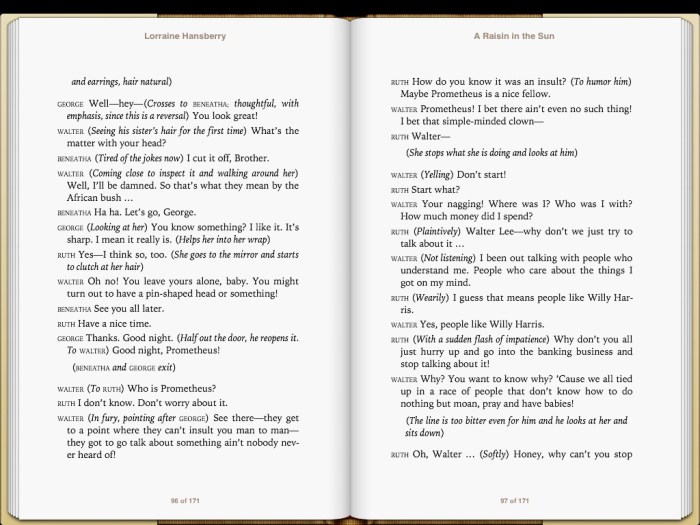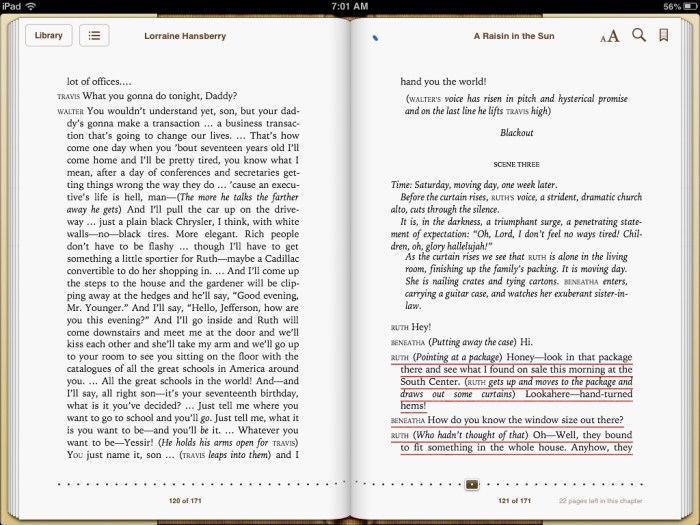Raisin in the sun pdf act 2 – In “Raisin in the Sun” PDF Act 2, the Younger family navigates a complex web of dreams, racial inequality, and family strife. This act delves into the characters’ struggles and triumphs, offering a poignant reflection of the challenges and aspirations of African Americans in the mid-20th century.
Walter Lee Younger, the patriarch of the family, grapples with the weight of his unfulfilled dreams and the pressures of providing for his loved ones. Ruth, his wife, remains a pillar of strength and resilience amidst the turmoil. Beneatha, their daughter, embodies the hope and aspirations of the younger generation.
Character Analysis: Raisin In The Sun Pdf Act 2

Act 2 of “A Raisin in the Sun” witnesses significant character development and complex interactions within the Younger family. This analysis will delve into the evolving nature of Walter, Ruth, and Beneatha, exploring their roles and contributions to the family dynamics.
Walter Lee Younger
Walter’s character undergoes a transformative journey in Act 2. His initial optimism and determination to pursue his dream of a liquor store begin to wane as he faces setbacks and the weight of family responsibilities. The pressure to provide for his family and the realization of the challenges he faces lead to moments of frustration and self-doubt.
Despite his struggles, Walter’s love for his family remains unwavering. He sacrifices his own aspirations to ensure their well-being, demonstrating his deep sense of responsibility and loyalty. However, his inability to reconcile his personal ambitions with the needs of his family creates inner turmoil and tension.
Ruth Younger
Ruth’s relationship with Walter evolves in Act 2 as she witnesses his emotional struggles and wavering determination. She provides unwavering support and encouragement, acting as a source of stability for Walter amidst his turmoil. However, Ruth’s own desires and ambitions are often overshadowed by her commitment to the family.
The tension between her desire for a better life and her loyalty to Walter becomes evident. Ruth’s frustration and resentment towards Walter’s unfulfilled promises begin to surface, creating a strain on their relationship. Yet, her love for him remains strong, and she continues to be a pillar of support for the family.
Beneatha Younger
Beneatha’s role in the family dynamics is significant in Act 2. As a young, educated woman, she represents a different path for the Younger family. Her pursuit of higher education and her interest in African culture challenge traditional gender roles and expectations.
Beneatha’s intellectual curiosity and determination inspire her family members, particularly Walter. However, her independent spirit and outspoken nature sometimes create conflicts within the family. Beneatha’s presence forces the family to confront their own values and aspirations, and her influence contributes to the evolving dynamics of the Younger household.
Themes and Motifs

Act 2 of A Raisin in the Sun delves deeper into the play’s central themes and employs various motifs to reinforce these ideas.
After diving into Act 2 of “Raisin in the Sun” PDF, I realized I needed a quick study break. So, I checked the FL Poly final exam schedule to plan my upcoming study sessions. Returning to “Raisin in the Sun,” I’m eager to explore the complexities of the Younger family’s journey as they navigate their dreams and challenges.
Pursuit of Dreams
The characters’ pursuit of dreams remains a prominent theme in Act 2. Walter’s unwavering determination to buy a house symbolizes his aspirations for a better life for his family. However, the obstacles he faces highlight the challenges faced by African Americans in a racially segregated society.
Racial Inequality
Racial inequality permeates Act 2. The Youngers’ struggle to find a decent home in a white neighborhood reflects the systemic racism that limits their opportunities. Beneatha’s encounter with Karl Lindner further exposes the prejudice and discrimination that African Americans endure.
Family Conflict
Act 2 explores the complexities of family relationships. Walter’s ambition and financial desperation strain his bond with his wife, Ruth. Beneatha’s desire for independence and her clash with Walter over her future add to the familial tensions.
Motif of the Sun
The image of the sun serves as a recurring motif in Act 2. Walter’s dream of buying a house in Clybourne Park is associated with the sun’s promise of a brighter future. However, the sun’s absence during the Younger family’s visit to the neighborhood foreshadows the challenges they will face.
Symbolism of the House
The house symbolizes both the Youngers’ aspirations and the obstacles they encounter. Walter’s unwavering determination to purchase the house represents his desire for a better life, while the resistance he faces from white society highlights the barriers faced by African Americans.
Plot Summary and Analysis

Act 2 of A Raisin in the Sununfolds in the Younger family’s new home in Clybourne Park. The excitement of their move is tempered by financial concerns and escalating tensions among family members.
Key Events
- Walter loses his job due to his alcoholism.
- Beneatha and George Murchison, a wealthy suitor, clash over their different values.
- Walter hatches a plan to invest in a liquor store, but it fails.
- The family faces eviction due to Walter’s financial recklessness.
Conflicts
Act 2 highlights several significant conflicts:
- Walter vs. the family:Walter’s dreams of financial success clash with the family’s desire for stability.
- Beneatha vs. George:Beneatha’s aspirations and independence conflict with George’s traditional values.
- The family vs. society:The Youngers face discrimination and prejudice in their new neighborhood.
Foreshadowing and Suspense
Several events in Act 2 foreshadow future developments and create suspense:
- Walter’s job loss hints at his inability to provide for the family.
- Beneatha’s clash with George foreshadows her rejection of societal norms.
- Walter’s investment scheme foreshadows his financial downfall.
- The threat of eviction creates a sense of urgency and tension.
Literary Devices and Techniques

August Wilson’s “Raisin in the Sun” employs various literary devices to enhance the reader’s understanding of characters, themes, and the play’s overall significance.
Foreshadowing
Foreshadowing is used throughout Act 2 to hint at future events and create a sense of anticipation. For example, Beneatha’s dream of becoming a doctor foreshadows her future success and determination.
Symbolism
Symbolism is used to represent abstract ideas and emotions. The “raisin in the sun” symbolizes the family’s hope for a better future, while the cramped apartment represents their current struggles.
Irony
Irony is used to create a contrast between what is expected and what actually happens. For example, the irony of the family’s dreams being crushed by the insurance company’s refusal to pay out on Mama’s insurance policy.
Language and Dialogue
Wilson’s use of language and dialogue conveys meaning and character development. The poetic language used by Mama and Beneatha reflects their intelligence and aspirations, while the colloquial language of Walter and Ruth reveals their more down-to-earth nature.
Social and Historical Context

Lorraine Hansberry’s “Raisin in the Sun” was written and set in the 1950s, a period of significant social and historical change in the United States. The play reflects the experiences and challenges faced by African Americans during this time, particularly in the context of housing discrimination, economic inequality, and the struggle for racial equality.
Housing Discrimination
During the 1950s, housing discrimination was rampant in the United States, with African Americans often denied access to decent and affordable housing. This was due to a combination of factors, including restrictive covenants, redlining, and racial steering. “Raisin in the Sun” depicts this discrimination through the Younger family’s struggle to find a new home.
Despite having saved up enough money for a down payment, they are repeatedly denied the opportunity to purchase a home in a white neighborhood.
Economic Inequality
Economic inequality was another major issue facing African Americans in the 1950s. Despite making some economic gains during World War II, they still faced significant barriers to employment and advancement. The Younger family in “Raisin in the Sun” is a reflection of this economic inequality.
Walter Lee Younger, the protagonist, works as a chauffeur but dreams of a better life for himself and his family.
Struggle for Racial Equality
The 1950s was also a time of great struggle for racial equality. The Civil Rights Movement was gaining momentum, but there was still widespread resistance to desegregation and other forms of racial equality. “Raisin in the Sun” reflects this struggle through the Younger family’s interactions with the white community.
They are constantly reminded of their status as second-class citizens, and they must constantly fight for their rights.
Continued Relevance, Raisin in the sun pdf act 2
“Raisin in the Sun” continues to resonate with audiences today because it addresses timeless themes of family, dreams, and the struggle for equality. The play’s depiction of the challenges faced by African Americans in the 1950s is still relevant today, as racism and economic inequality continue to be major issues in American society.
Key Questions Answered
What is the significance of the Younger family’s dream of buying a house?
The dream of buying a house represents the family’s aspirations for a better life, freedom from racial discrimination, and a sense of ownership and belonging.
How does Walter’s relationship with Ruth evolve in Act 2?
Walter becomes increasingly frustrated and distant from Ruth as his dreams seem to slip away. Ruth, however, remains steadfast in her love and support for him.
What role does Beneatha play in the family dynamics?
Beneatha represents the hope and aspirations of the younger generation. She is determined to pursue her education and break free from the limitations imposed by society.
